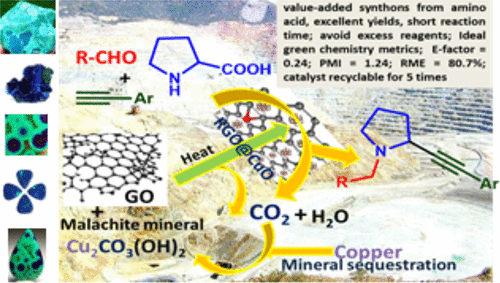当前位置:
X-MOL 学术
›
ACS Sustain. Chem. Eng.
›
论文详情
Our official English website, www.x-mol.net, welcomes your feedback! (Note: you will need to create a separate account there.)
Reduced Graphene Oxide Supported Copper Oxide Nanocomposites from a Renewable Copper Mineral Precursor: A Green Approach for Decarboxylative C(sp3)–H Activation of Proline Amino Acid To Afford Value-Added Synthons
ACS Sustainable Chemistry & Engineering ( IF 8.4 ) Pub Date : 2018-06-16 00:00:00 , DOI: 10.1021/acssuschemeng.8b01376 Upasana Gulati 1 , U. Chinna Rajesh 1, 2 , Diwan S. Rawat 1
ACS Sustainable Chemistry & Engineering ( IF 8.4 ) Pub Date : 2018-06-16 00:00:00 , DOI: 10.1021/acssuschemeng.8b01376 Upasana Gulati 1 , U. Chinna Rajesh 1, 2 , Diwan S. Rawat 1
Affiliation

|
A green approach for decarboxylative C(sp3)–H activation of proline amino acid was accomplished by coupling with aldehydes and alkynes to afford α-alkynylated N-substituted pyrrolidines as value-added synthons using reduced graphene oxide supported copper oxide ([email protected]) nanocatalysts. The [email protected] nanocomposites were obtained by the impregnation of micrometer-sized malachite spheres, as a renewable and sustainable copper mineral precursor, on the graphene oxide (GO) sheets followed by calcination at 300–450 °C for 5 h. The characterization of as-synthesized composites revealed the generation of monodispersed and uniformly embedded copper oxide (CuO) nanoparticles with sizes ranging from 10 to 15 nm on RGO thin sheets via GO as a support as well as indirect template for dissembling and decomposition of micrometer-sized malachite spheres. The [email protected] composites were found to be efficient and robust nanocatalysts compared with CuO nanoparticles (NPs) alone. The present method offers several advantages, such as wide substrate scope, and avoids the usage of excess equivalent of substrates with minimal waste generation (E-factor = 0.24) and high reaction mass efficiency (80.7%), and the nanocatalyst was recycled for five times without significant loss in its activity with a negligible leaching of CuO NPs from RGO sheets.
中文翻译:

从可再生的铜矿物前体中还原氧化石墨烯支持的氧化铜纳米复合材料:脯氨酸脱羧C(sp 3)–H活化为Afford增值合成子的绿色方法
脱羧C(sp 3)的绿色方法脯氨酸氨基酸的H-H活化是通过与醛和炔烃偶联而完成的,使用还原型氧化石墨烯负载的氧化铜([受电子邮件保护])纳米催化剂,可将α-炔基化的N-取代的吡咯烷类作为增值合成子。[受电子邮件保护的]纳米复合材料是通过将微米尺寸的孔雀石球(可再生和可持续的铜矿物前体)浸渍在氧化石墨烯(GO)片上,然后在300–450°C下煅烧5小时而获得的。合成后的复合材料的表征显示,通过GO作为载体,在RGO薄片上生成了尺寸为10至15 nm的单分散且均匀包埋的氧化铜(CuO)纳米粒子,以及用于分解和分解微米级的间接模板。大小的孔雀石球。与单独的CuO纳米颗粒(NPs)相比,发现[受电子邮件保护的]复合材料是有效且坚固的纳米催化剂。本方法具有多种优点,例如底物范围宽,并且避免了使用过量当量底物,产生废物最少(E因子= 0.24)和高反应质量效率(80.7%),并且将纳米催化剂循环使用了五次。从RGO片中浸出的CuO NP几乎可以忽略不计,而其活性没有明显损失。
更新日期:2018-06-16
中文翻译:

从可再生的铜矿物前体中还原氧化石墨烯支持的氧化铜纳米复合材料:脯氨酸脱羧C(sp 3)–H活化为Afford增值合成子的绿色方法
脱羧C(sp 3)的绿色方法脯氨酸氨基酸的H-H活化是通过与醛和炔烃偶联而完成的,使用还原型氧化石墨烯负载的氧化铜([受电子邮件保护])纳米催化剂,可将α-炔基化的N-取代的吡咯烷类作为增值合成子。[受电子邮件保护的]纳米复合材料是通过将微米尺寸的孔雀石球(可再生和可持续的铜矿物前体)浸渍在氧化石墨烯(GO)片上,然后在300–450°C下煅烧5小时而获得的。合成后的复合材料的表征显示,通过GO作为载体,在RGO薄片上生成了尺寸为10至15 nm的单分散且均匀包埋的氧化铜(CuO)纳米粒子,以及用于分解和分解微米级的间接模板。大小的孔雀石球。与单独的CuO纳米颗粒(NPs)相比,发现[受电子邮件保护的]复合材料是有效且坚固的纳米催化剂。本方法具有多种优点,例如底物范围宽,并且避免了使用过量当量底物,产生废物最少(E因子= 0.24)和高反应质量效率(80.7%),并且将纳米催化剂循环使用了五次。从RGO片中浸出的CuO NP几乎可以忽略不计,而其活性没有明显损失。


























 京公网安备 11010802027423号
京公网安备 11010802027423号